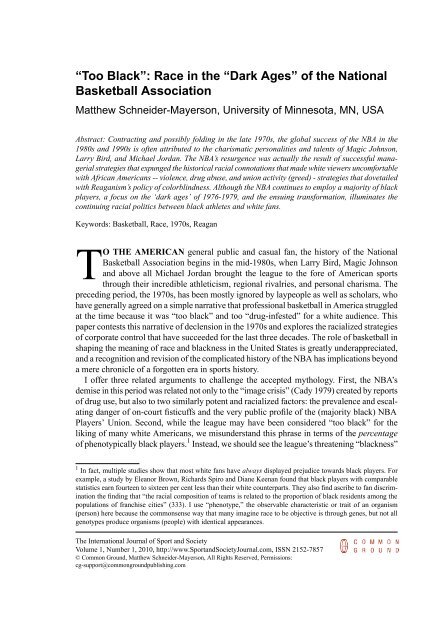Download - University of Minnesota
Download - University of Minnesota
Download - University of Minnesota
Create successful ePaper yourself
Turn your PDF publications into a flip-book with our unique Google optimized e-Paper software.
“Too Black”: Race in the “Dark Ages” <strong>of</strong> the National<br />
Basketball Association<br />
Matthew Schneider-Mayerson, <strong>University</strong> <strong>of</strong> <strong>Minnesota</strong>, MN, USA<br />
Abstract: Contracting and possibly folding in the late 1970s, the global success <strong>of</strong> the NBA in the<br />
1980s and 1990s is <strong>of</strong>ten attributed to the charismatic personalities and talents <strong>of</strong> Magic Johnson,<br />
Larry Bird, and Michael Jordan. The NBA’s resurgence was actually the result <strong>of</strong> successful managerial<br />
strategies that expunged the historical racial connotations that made white viewers uncomfortable<br />
with African Americans -- violence, drug abuse, and union activity (greed) - strategies that dovetailed<br />
with Reaganism’s policy <strong>of</strong> colorblindness. Although the NBA continues to employ a majority <strong>of</strong> black<br />
players, a focus on the ‘dark ages’ <strong>of</strong> 1976-1979, and the ensuing transformation, illuminates the<br />
continuing racial politics between black athletes and white fans.<br />
Keywords: Basketball, Race, 1970s, Reagan<br />
TO THE AMERICAN general public and casual fan, the history <strong>of</strong> the National<br />
Basketball Association begins in the mid-1980s, when Larry Bird, Magic Johnson<br />
and above all Michael Jordan brought the league to the fore <strong>of</strong> American sports<br />
through their incredible athleticism, regional rivalries, and personal charisma. The<br />
preceding period, the 1970s, has been mostly ignored by laypeople as well as scholars, who<br />
have generally agreed on a simple narrative that pr<strong>of</strong>essional basketball in America struggled<br />
at the time because it was “too black” and too “drug-infested” for a white audience. This<br />
paper contests this narrative <strong>of</strong> declension in the 1970s and explores the racialized strategies<br />
<strong>of</strong> corporate control that have succeeded for the last three decades. The role <strong>of</strong> basketball in<br />
shaping the meaning <strong>of</strong> race and blackness in the United States is greatly underappreciated,<br />
and a recognition and revision <strong>of</strong> the complicated history <strong>of</strong> the NBA has implications beyond<br />
a mere chronicle <strong>of</strong> a forgotten era in sports history.<br />
I <strong>of</strong>fer three related arguments to challenge the accepted mythology. First, the NBA’s<br />
demise in this period was related not only to the “image crisis” (Cady 1979) created by reports<br />
<strong>of</strong> drug use, but also to two similarly potent and racialized factors: the prevalence and escalating<br />
danger <strong>of</strong> on-court fisticuffs and the very public pr<strong>of</strong>ile <strong>of</strong> the (majority black) NBA<br />
Players’ Union. Second, while the league may have been considered “too black” for the<br />
liking <strong>of</strong> many white Americans, we misunderstand this phrase in terms <strong>of</strong> the percentage<br />
<strong>of</strong> phenotypically black players. 1 Instead, we should see the league’s threatening “blackness”<br />
1 In fact, multiple studies show that most white fans have always displayed prejudice towards black players. For<br />
example, a study by Eleanor Brown, Richards Spiro and Diane Keenan found that black players with comparable<br />
statistics earn fourteen to sixteen per cent less than their white counterparts. They also find ascribe to fan discrimination<br />
the finding that “the racial composition <strong>of</strong> teams is related to the proportion <strong>of</strong> black residents among the<br />
populations <strong>of</strong> franchise cities” (333). I use “phenotype,” the observable characteristic or trait <strong>of</strong> an organism<br />
(person) here because the commonsense way that many imagine race to be objective is through genes, but not all<br />
genotypes produce organisms (people) with identical appearances.<br />
The International Journal <strong>of</strong> Sport and Society<br />
Volume 1, Number 1, 2010, http://www.SportandSocietyJournal.com, ISSN 2152-7857<br />
© Common Ground, Matthew Schneider-Mayerson, All Rights Reserved, Permissions:<br />
cg-support@commongroundpublishing.com

















